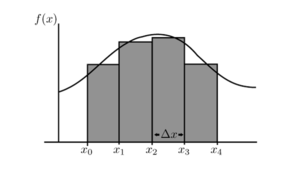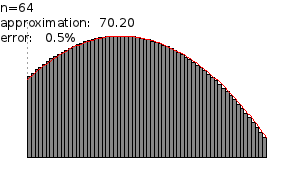In order to apply the techniques we make the following considerations:
- The degree of the numerator must be one degree less than that of the denominator
- The denominator must be decomposed into a product of factors. The number of factors will determine the number of partial fractions. Example: the function 2x + 3/(x+1)(x+2) can be decomposed as the sum of A/x+1 + B/x+2.
- If the denominator is not decomposed into a product of factors it has to be so. Example: the function f(x) = 3x + 1/x² + 5x + 6 cannot be decomposed unless we factor it in a product of factors. Factoring the denominator as (x+2)(x+3) the function can be decomposed as: 3x + 1/(x+2)(x+3) = A/x+2 + B/x+3
- If the denominator is a power like (x + a)ⁿ then a rational function like N/(x + a)ⁿ can be written as: N/(x + a)ⁿ = A₁/x + a + A₂/(x+a)² + A₃/(x + a)³+.....An/(x+a)ⁿ
Example 1 Find the integral of the function f(x) = 2x+3/(x+1)(x+2)
The denominator is decomposed into 2 factors. The fraction can be decomposed into 2 partial fractions as follows:
2x+3/(x+1)(x+2) = A/x+1 + B/x+2
The goal here is to determine A and B. In order to do that, we have to go through a number of steps
1) Making the equality above identically equal. That will happen when the denominator of the fraction on the second side of the equation is equal to to the denominator of the fraction on the first side of the equation. The numerator of the fraction on the second side is written in the same way as the numerator of the fraction on the first side of the equation
2) Set a system of 2 equations containing A and B in order to determine these unknown
3) Substitute A and B in the expression: 2x+3/(x+1)(x+2) = A/x+1 + B/x+2
Let's do step 1:
2x+3/(x+1)(x+2) = A(x+2) + B(x + 1)/ (x+1)(x+2)
2x+3/(x+1)(x+2) = Ax + 2A + Bx + B/ (x + 1) (x + 2)
2x+3/(x+1)(x+2) = (A + B)x + 2A + B/(x + 1) (x + 2
Let's simplify by (x + 1) (x + 2):
2x + 3 = (A + B)x + 2A + B
Now we can go to step 2:
By identification we have: A + B = 2 (1) 3 (2) 2A + B = 3
Let's solve this system of the 2 equarions by multiplying the first equarion by -2 and adding the new equation to the second equation
-2A-2 B = -4
2A + B = 3
We then obtain: -B = -1 B = 1
Let's substitute B in the second equation
:2A + 1 = 3
2A = 2 A = 1
Let's go to the final step 3:
Let's substitute A and B in the expression developed above:
2x + 3/(x+1)(x+2) = 1/x + 1 + 1/x+2
Now we can calculate the integral of 2x + 3/ (x + 1) (x + 2):
∫ (2x + 3/(x+1)(x+2) = ∫(1/x + 1 + 1/x + 2)dx
= ∫1/x + 1dx + ∫1/x + 2 dx
= ln❘x + 1❘ + ln❘x + 2❘ + C
Example 2. Find the integral of the function f(x) = 3x + 1/x² + 5x + 6
Let's factor the denominator: x² + 5x + 6 = (x + 2) (x + 3)
Now the function can be written as: f(x) = 3x + 1/ (x + 2) (x + 3)
Let's decompose the function in partial fractions:
3x + 1/ (x + 2) (x + 3) = A/x + 2 + B/x + 3
Step 1
In order to determine A and B let's do the first step which consists in making the expression above identically equal:
3x + 1/ (x + 2) (x + 3) = A(x + 3) + B(x + 2)/ (x + 2) (x + 3)
The equality of these two fractions implies the equality of the denominators and that of the numerators. The denominators being equal, let's equalize the numerators.
3x + 1 = A(x + 3) + B(x + 2)
3x + 1 = Ax + 3A + Bx + 2B
3x + 1 = (A + B)x + 3A + 2B
Now we go to step 2. The equality is true if the coefficients of x and the constant terms are equal:
Step 2
A + B = 3 (1) 3A + 2B = 1 (2)
Let's multiply the first equation by -3 and add the new equation to the second equation
-3A - 3B = -6 (3)
3A + 2B = 1 (2)
B = -5
Let's substitute B in the first equation
A-5 = 3 A = 8
Step 3
Let's substitute A and B in the decomposed function above:
3x + 1/ (x + 2) (x + 3) = 8/x + 3 - 5/x + 2
Let's integrate both sides
:
∫3x + 1/ (x + 2) (x + 3)dx = ∫(8/x + 3 - 5/x + 2)dx = ∫8/x + 3dx - ∫5/x + 2)dx = 8∫1/x + 3dx -5∫1/x + 2dx = 8ln❘x + 3❘-5ln❘x + 2❘ + C
From the example above we can set the general rule:
1) Decompose the rational function into an expression containing unknowns to determine: A, B, C, etc.
2) Make the equation identically equal
3) Set a system of equations that allow to determine the unknowns
4) When the unknowns are determined. substitute them in the function theoretically decomposed.
5) Calculate the integral
Practice: Integrate the function: f(x) = 2x-3/(3x + 1)²
Interested about learning more about integration visit Center for Integral Development














